Thursday, September 18, 2014
Amanda Tote/Purse sew along
The first step of the sew along is now available on Boutique Birdie's blog.
Wednesday, September 10, 2014
Sew Along for the Amanda Cross-Body Purse and Amanda Quilted Tote
Starting on Monday, Sept. 15th, Tricia Laporte Whelan and Heather Turner will be hosting a sew along in the Funktional Threads Pattern group on Facebook! They will break up the construction steps into sections with a few days in between each section. All the steps will be kept in the group so you can refer back to them in the future. So gather up your fabric and supplies and check into the group on Monday for step 1!
To purchase the patterns, go to my Craftsy shop where you can find the Amanda Cross-Body Purse and the Amanda Quilted Tote as well as the Amanda Quilted Bundle which includes the purse and tote.
Friday, August 22, 2014
Back to School Sale - save 35%
I know school has already started in many areas but we still have a little over a week before my daughter goes back. I'm finally getting myself in the "summer's over" frame of mind so I'm offering a Back-To-School sale in my Etsy shop. Use code BTS35 to get 35% off your entire purchase in my Etsy shop.
Monday, August 4, 2014
Pre-release offer on upcoming patterns
I have two new patterns in the early stages of testing - the Amanda Cross-Body Purse and the Amanda Quilted Tote. I have these listed for pre-sale in my Craftsy shop. I also have a bundle offer for both of these new patterns. My target for release of them is August 15th. If you pre-purchase, you'll pay less than the regular price that will be in place once the pattern is ready for release.
When you purchase, you'll be able to download a small PDF that will contain sizing, yardage and notions so you can begin gathering the supplies you need. Once the patterns are ready for release, I'll edit the Craftsy listings. When I edit them, Craftsy will then send notice that a new version of the PDF is available. I'll also post in my Facebook group to verify that they are ready.
Click below to go to the listings for this special offer:
The Amanda Cross-Body Purse
The Amanda Quilted Tote
The Amanda Cross-Body Purse and Quilted Tote Bundle
When you purchase, you'll be able to download a small PDF that will contain sizing, yardage and notions so you can begin gathering the supplies you need. Once the patterns are ready for release, I'll edit the Craftsy listings. When I edit them, Craftsy will then send notice that a new version of the PDF is available. I'll also post in my Facebook group to verify that they are ready.
Click below to go to the listings for this special offer:
The Amanda Cross-Body Purse
The Amanda Quilted Tote
The Amanda Cross-Body Purse and Quilted Tote Bundle
Thursday, July 31, 2014
Rachel Knit Dress - Shoulder Strap Tutorial by Tricia of Treasure Lee Boutique
The following tutorial is a fun version of my Rachel Knit Dress pattern. This tutorial is a variation of the dress created and documented by Tricia of Treasure Lee Boutique.

|
For this variation, you'll need: * Front (one piece or pieced is up to you) * Back * Flounce (I used the Bottom and Top flounces only but any of the options included in the pattern will work well) Note: You do not need sleeves or the neck binding listed in the pattern |
|
With right sides together, stitch Front to Back along the sides from underarm to bottom. Finish the seams as desired. Note: Leave these pieces right sides together for the next step. |
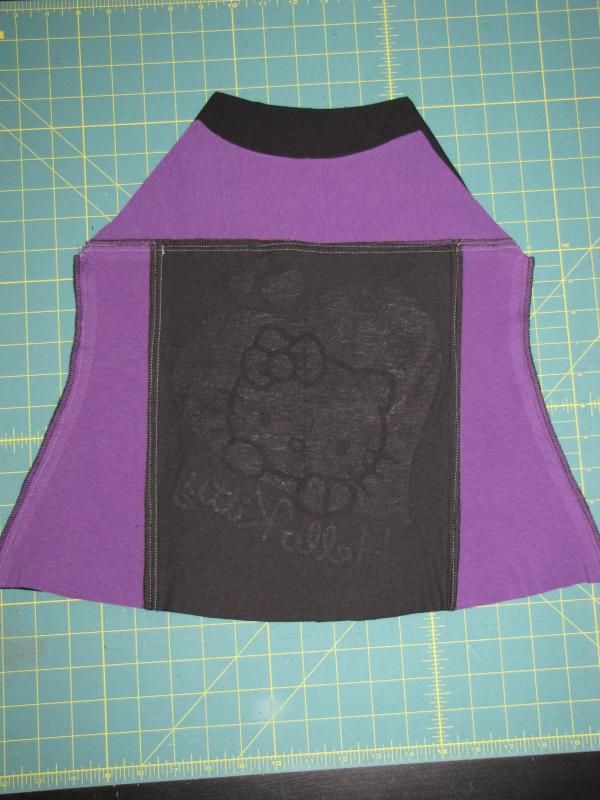
|
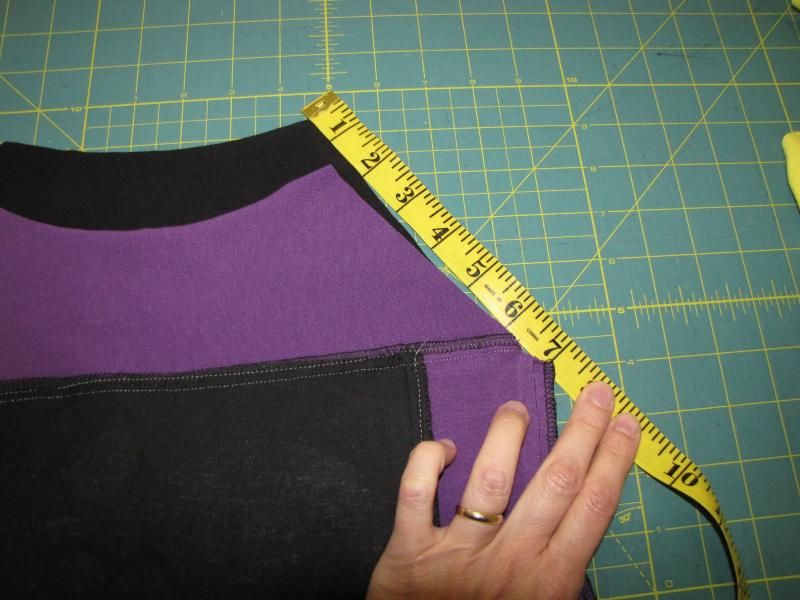
|
Next you'll determine how much 2" wide binding you'll need. First, measure along the sleeve edges of the Front and Back. In my example, the total length of these was about 12". Add at least 24" to that measurement for the tie straps. (Note: I used 36" for my total length but it was JUST enough so I think I'd add a few extra inches next time.) Measure across to upper edge of the Front and also along the upper edge of the Back. For the size 6 of my example, I cut these 9" in length. Now cut 2 sleeve edge binding pieces (one for each armedge plus straps) 36" x 2" and two pieces 9" x 2" for the Front binding and Back edge bindings. Note: You're pieces may be a different length based on the size you're making. Note: Cut the binding so the longest dimension goes across the width of the knit. |
| Here are my sleeve edge bindings cut. There are shorter pieces for the front and back neckline missing from this picture but you'll see them later. :) | 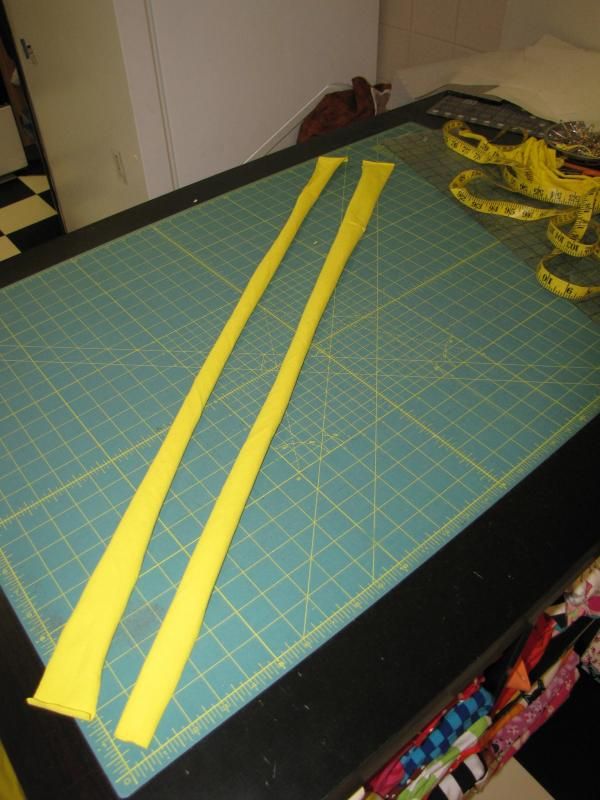
|

|
Fold both short ends of one sleeve edge binding 1/2" toward the wrong side and press. Repeat with the other sleeve edge binding. This will give you neat ends on your straps later. |
| With wrong sides together, fold one sleeve edge binding in half along the length and press. Repeat with the other sleeve edge binding as well as the Front and Back bindings. | 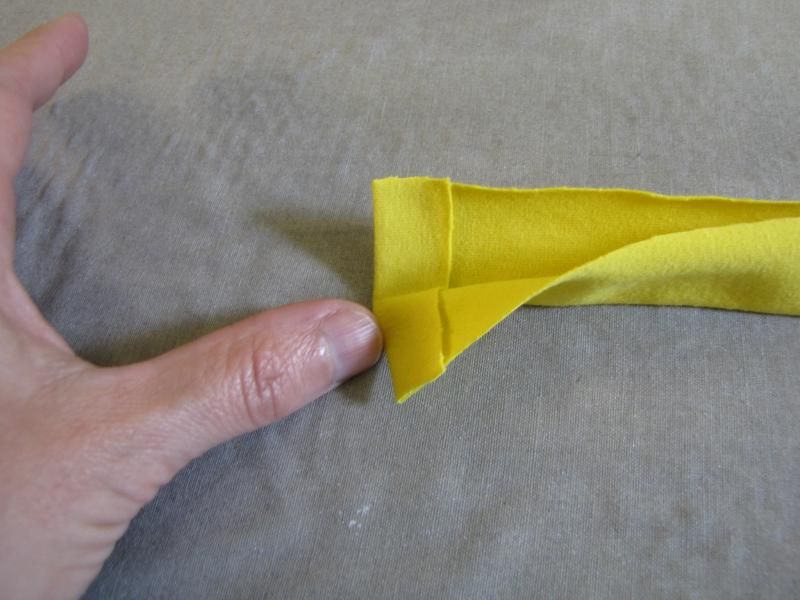
|
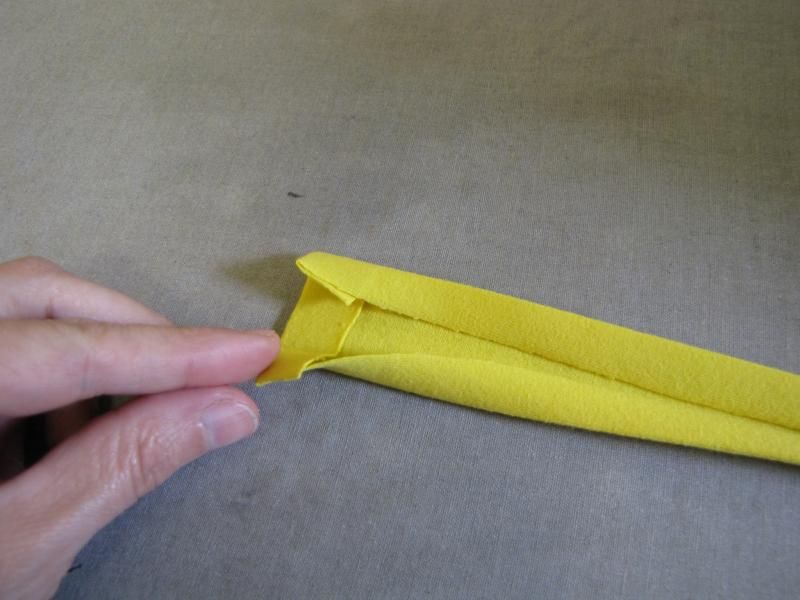
|
Unfold one sleeve edge binding along the length, fold each long edge to the center crease and press. Fold again along the center crease and press once again. Repeat with the other sleeve edge binding as well as the Front and Back bindings. |
| This may seem like a lot of pressing but it's worth it so you end up with a nice neat length of binding. | 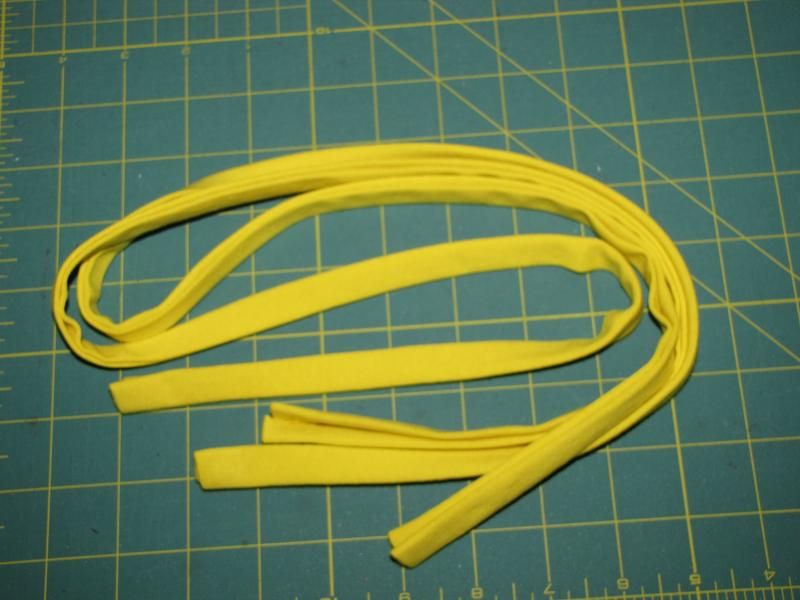
|
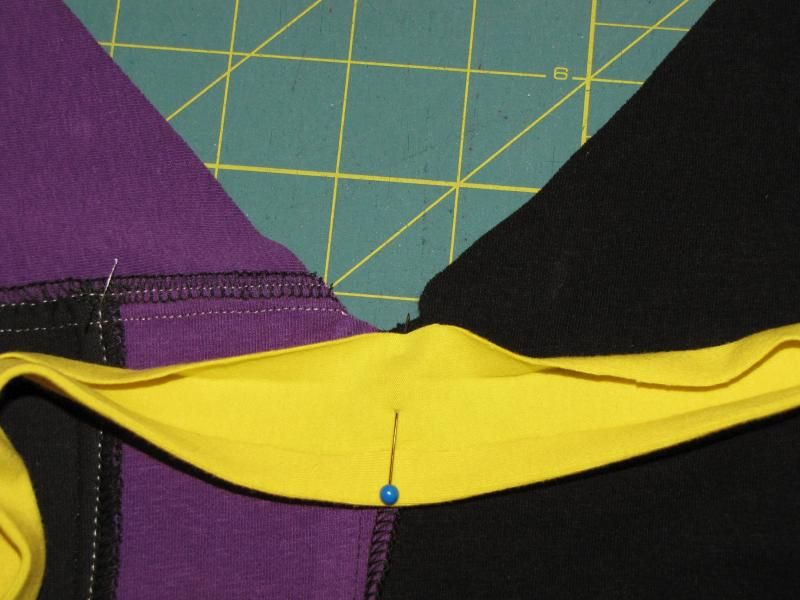
|
With the bodice inside out, unfold one side of the Front binding along the upper edge of the Front, matching up the raw edges. (Note: the right side of the binding will face the wrong side of the Front). Stitch along the crease line. Note: I stretched the binding just a bit when doing this so that it will spring back to laying flat when I am done. Repeat with the binding on the Back. |
| Turn the bodice right side out. Your Front binding should look like this. | 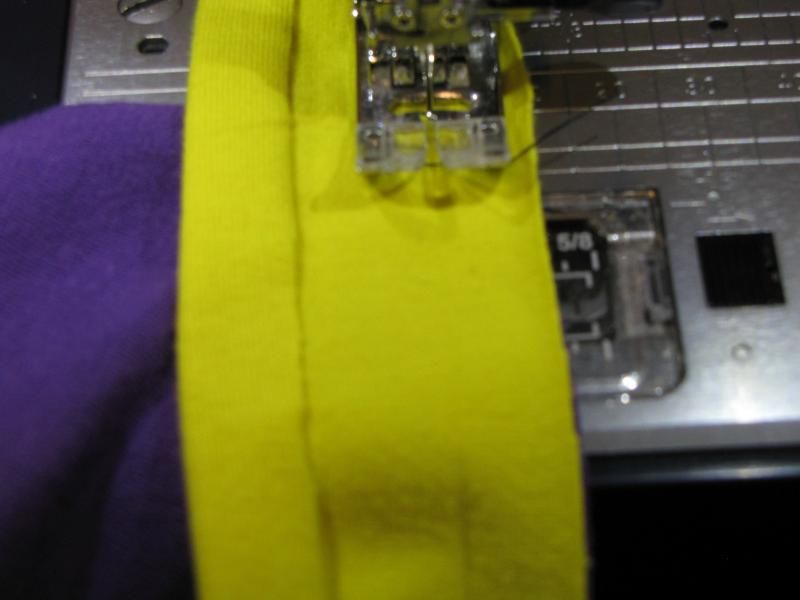
|
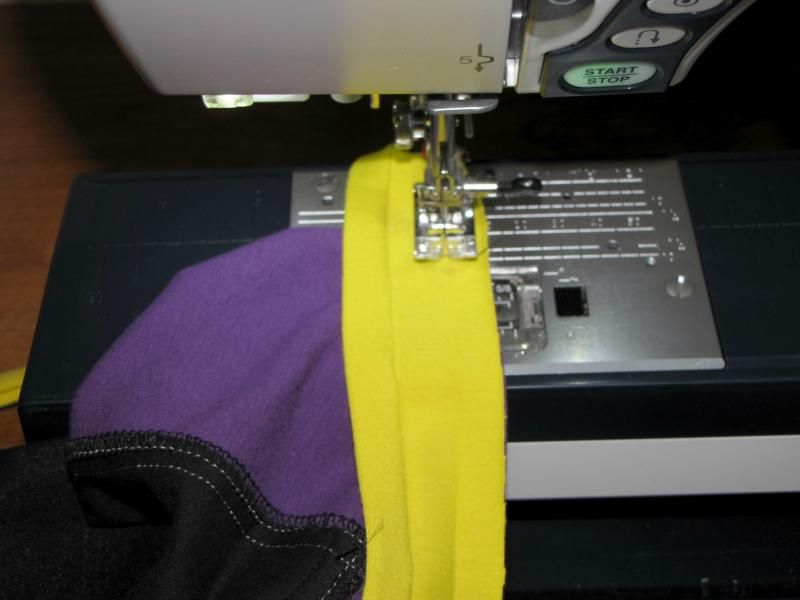
|
Fold the Front Binding to the right side of the Front keeping the binding's center fold along the upper edge. Pin in place if desired. (Note: the right side of the binding will face the right side of the Front.) Repeat with the binding on the Back. |
|
On the right side of the Front, stitch along the Front binding close to the lower folded edge. Repeat with the binding on the Back. |
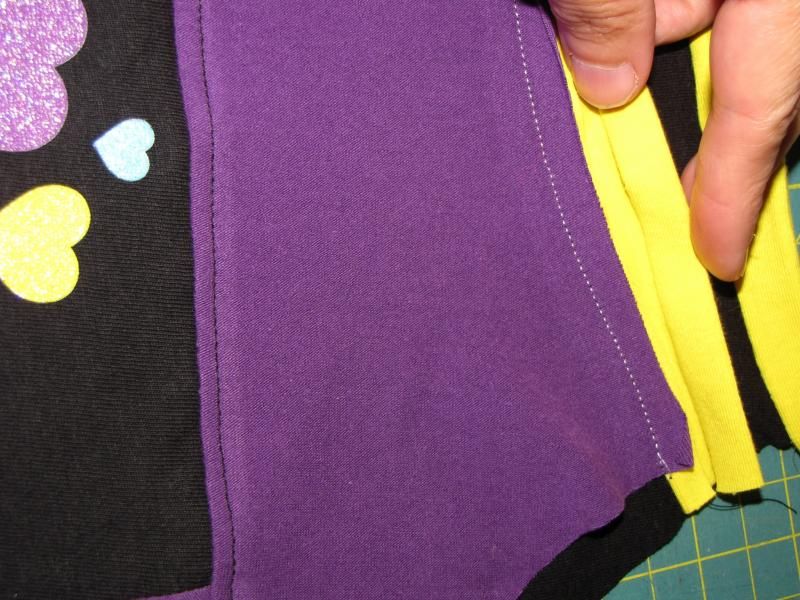
|

|
Take one sleeve edge binding and find the center of the length. Unfold the binding and pin the center point to the side seam of the bodice. (Note: the right side of the binding will face the wrong side of the bodice.) Now line one edge of the binding along the Front and the Back to the neckline edge, matching the raw edges of each and pinning as needed. |
|
Starting at the front neckline edge, sew the sleeve edge binding to the bodice from the back neckline edge to the front. Repeat with the other sleeve edge binding on the other armhole edge. |
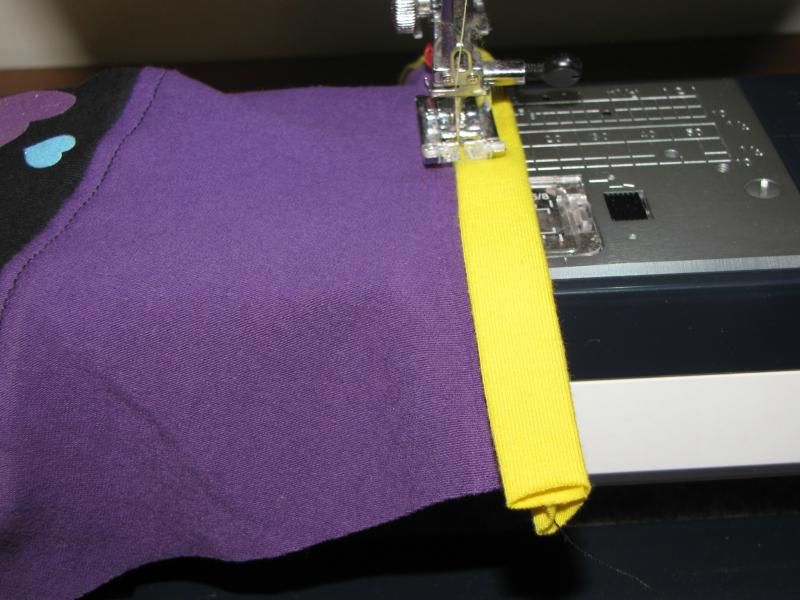
|
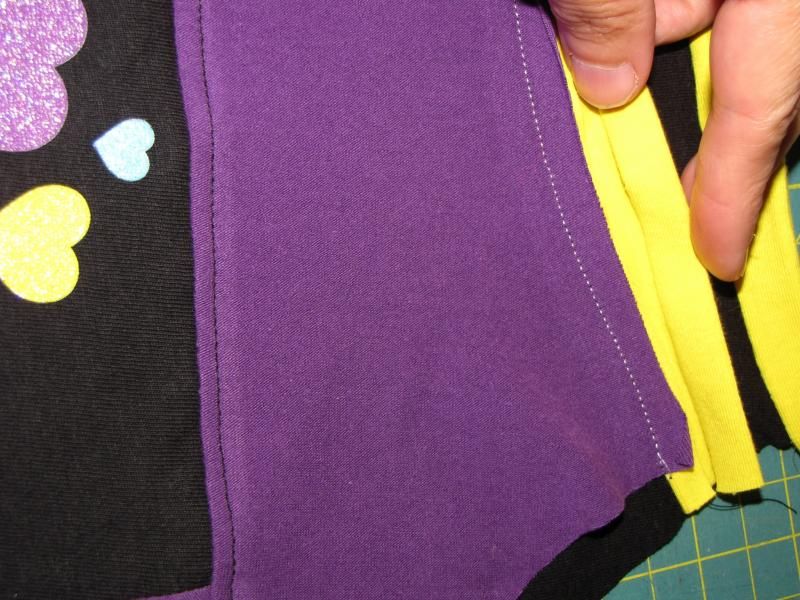
|
It should look like this on the front. Note: I forgot to take a pic of the arm binding but it looks the same at this step as the Front edge binding. |
|
Next, topstitch from one end of the sleeve edge binding strap all the way to to the other end making sure to backstitch at both ends. Tip: The bobbin stitching on the strap area will show so make sure you use bobbin thread that matches the thread in the needle. |
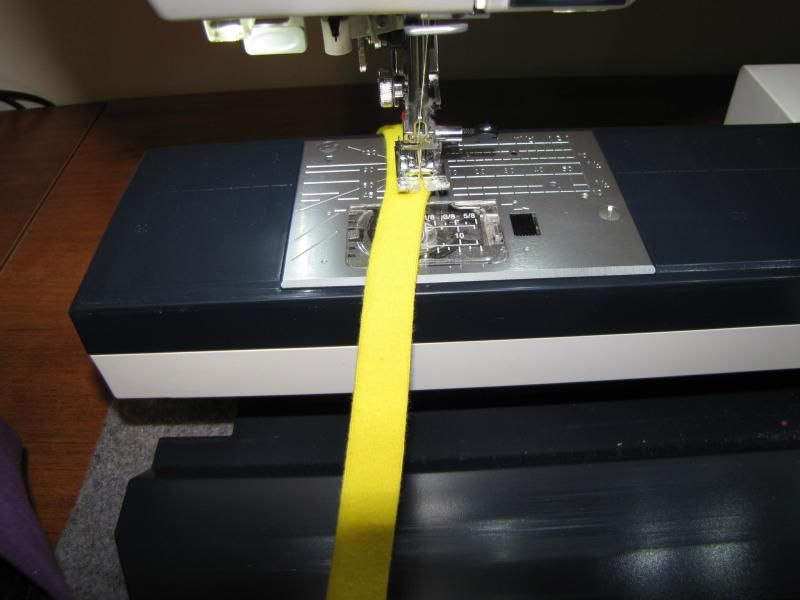
|
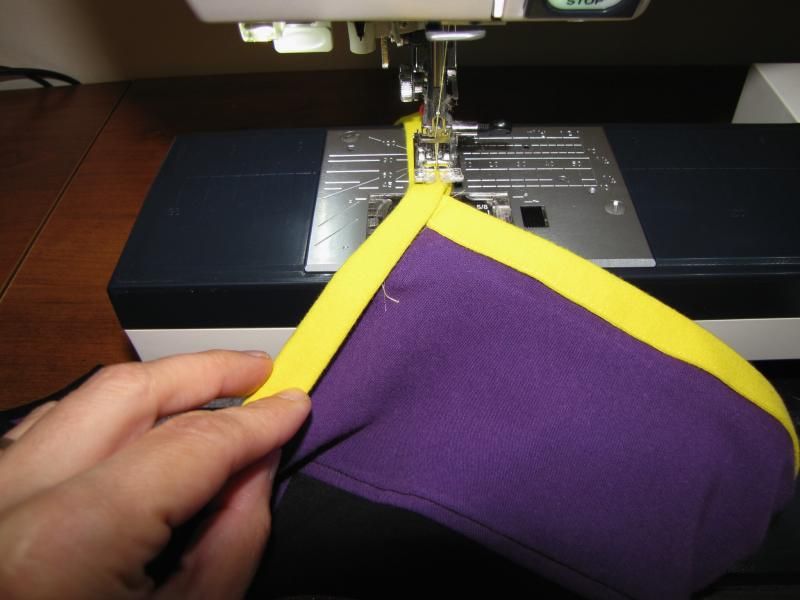
|
When you get to the point where the sleeve edge binding meets the Front or Back edge binding, make sure the raw edges of the Front/Back edge binding are neatly tucked in so there are no exposed edges. |
| Tip: I had a bit of a hard time starting to sew at the end of the straps where the knit is so thick so I think when I do this again, I'll start my topstitching at the side seam and sew to one strap end then go back under the arm and sew to the other end. | 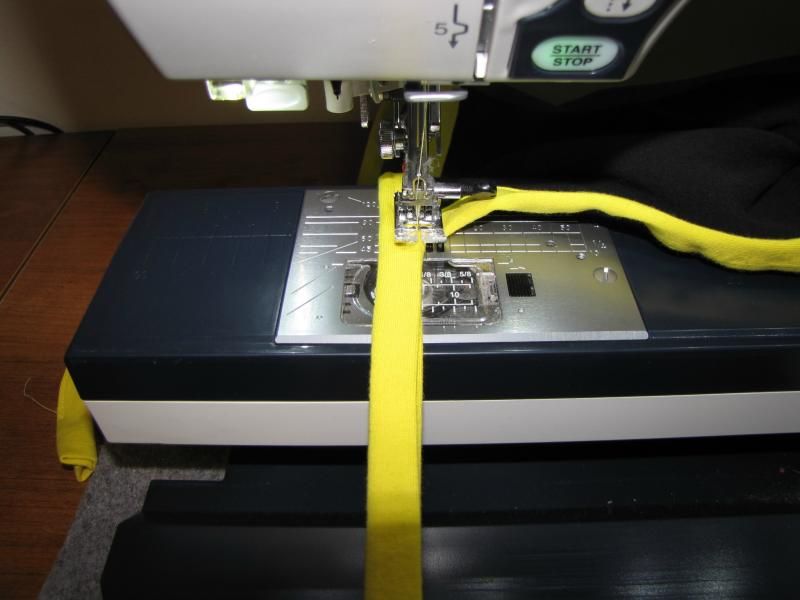
|
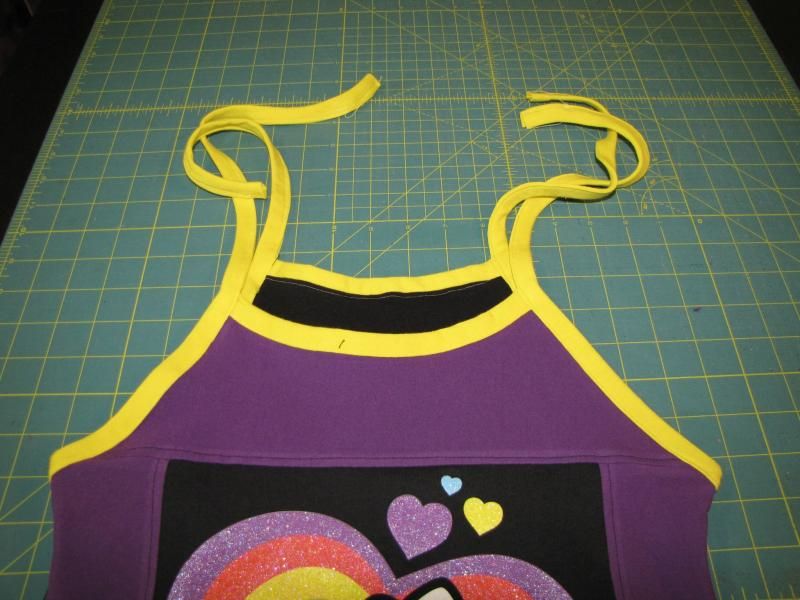
|
This is what the finished straps and binding look like. Finish the skirt flounces as directed in the pattern. |
Friday, May 2, 2014
Buy One Get One sale
Flash Sale: For the next 4 hours (until 6:15pm PST), Buy One, Get One free in my Craftsy Shop. Buy one pattern and send me a note when you pay through Paypal of which one you'd like free. The free pattern will be emailed within 24 hours of receipt of payment.
Note: Free pattern must be of equal or lower price to the one purchased.
Tuesday, April 1, 2014
Spring sale - save 30%
I feel like celebrating a bit since my FB pattern group has gone over 1500 members, my fan page is over 2500 and I started a new blog (yeah, I haven't done much with it yet but I will :) ). So, until tomorrow, 4/2, at midnight you can save 30% on all your purchases in my Etsy shop using the coupon code SPRING30.
Saturday, March 22, 2014
Vida "Sew-A-Long" Tutorial
Note: This tutorial is from my old blog and copied here to make it easier to find.
I love the Farbenmix Vida dress. It's so versatile and fun to make. I also think it's a good pattern for people who are new to sewing while definitely a good 'canvas' for those who love to embellish a garment. I don't know how many dresses I've made but I certainly haven't run out of ideas. I especially love that I can easily use several prints on one dress - a great way to use some remnants from previous projects. Some day I want to make a dress where no two pieces are cut from the same print.
Although the pattern and instructions are easy to follow, I know some people find it helps to have more detailed steps and photos of the process. As such, I decided to document the main steps I go through as I create a dress. I hope this helps others as they start their own exploration of the possibilities with this pattern.
Preparation
1) Farbenmix patterns are done in the 'Euro' style and do not include seam allowance. All pieces and sizes are printed on a single page of large paper. The pieces are not intended to be cut from that paper but instead it's necessary to trace each piece. Where the line is solid, all sizes share the same line. Where the sizes differ, the lines for each size is printed in a different type of line, i.e. dots, dashes, etc.
Tip: Go over the lines of the size you need with a colored pencil, crayon, highlighter or other tool to make it easier to see the line when tracing as described in step 2.
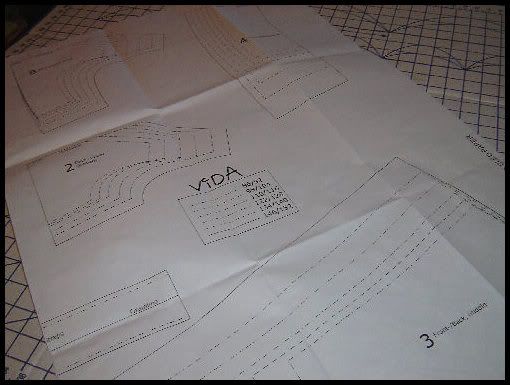
2) Trace all pattern pieces adding an even seam allowance to all sides of the piece EXCEPT where an edge is placed along a fold when cutting the fabric. For the Vida, this includes the center edge of these pieces: front upper (bodice), back upper (bodice), front bodice lining, back bodice lining, front/back middle and front/back lower. Transfer all pattern markings, such as grain line, to the traced piece. It also helps to label the pieces with their name and the size as well.
Tip: Plain white tissue paper is an inexpensive material to use for this purpose. However, if you'll be using the pattern repeatedly, using something more durable is a good idea. One option is to use non-woven lightweight interfacing (not the fusible kind). There is a product available at many fabric stores called Pattern Ease that is specifically designed for this type of use.
Tip: A simple tool to help you get an even seam allowance are two pencils taped or held together with a rubber band. Follow the line of the pattern with one pencil and have the other positioned so it goes along the outside of the pattern. As you trace the line, the second pencil will draw a parallel line that will be your cutting line.
Tip: I make dresses in a variety of sizes so I started color-coding my patterns when I trace them. For example all pieces for the size 86/92 are traced onto yellow tissue paper. This makes it easier for me to quickly find the right pattern pieces especially if I'm cutting two sizes out at once... something I do occasionally for sisters.
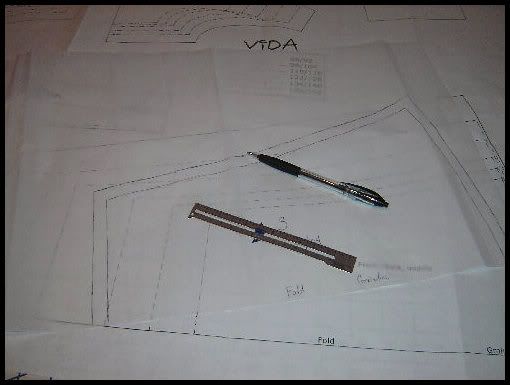
Cutting the Fabric
3) Cut all pieces as indicated on the pattern cutting list. Be sure to follow the markings for the grain line. For the pieces to be cut along the fold, place fabric with right sides together with the fold following the lengthwise grain of the fabric.
Tip: I love to use a different fabric for each main section of the dress. For example one fabric will be used for the front and back upper (bodice), a second for the front/back middle, a third for the front/back lower, a 4th for the straps (and I also use that fabric for an added bottom ruffle not included in the pattern) and one or two additional fabrics for the sides. I hate to use my wonderful fabric prints where they don't show so I typically use a solid fabric for the bodice lining.
Tip: If you plan to use different prints for the side panels, make sure you cut 2 with the pattern piece facing up (on the wrong side of the fabric) and 2 with the pattern piece facing down (on the wrong side of the fabric). What I like to do is use 2 different prints for the side. I have one fabric placed with right side up and lay the second over it with right side down. I then cut one set of pieces with the pattern right side up and repeat it exactly the same for the second set of pieces. By doing it this way, when the dress is finished, no two pieces of the same fabric are sewn together.
Tip: The side panels need to be cut slightly on the bias. This means the grain goes on an angle across the piece rather than straight up and down. To be sure I have the pattern piece oriented correctly, I measure from the marking on the pattern to the selvage of the fabric at both ends of the pattern piece.
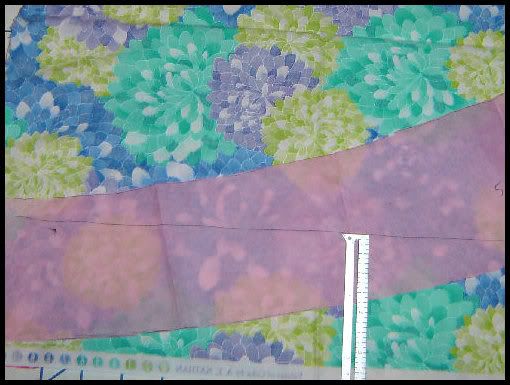
Appliqué
4) Once all pieces are cut, it's time to add any appliqué or similar embellishment that won't be added over a seam.
Assembly
5) Stitch the lower edge of the front upper (bodice) to the top edge of the front middle with right sides together. Make sure the center of each piece lines up. Repeat with the back upper (bodice) and back middle pieces. Finish the seam and press toward the bodice.
Tip: Once these pieces are stitched and the seam is finished, now is a good time to add ricrac or a similar trim over the seam line. This way the cut edge of the trim will be enclosed in seams in a later step.
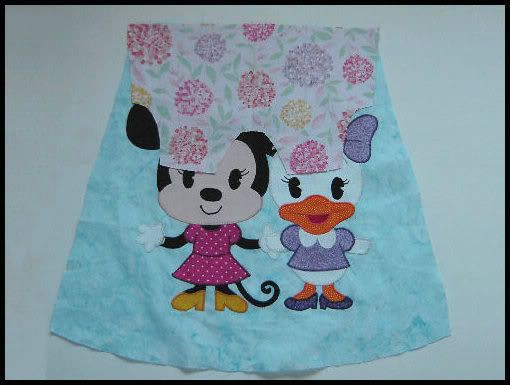
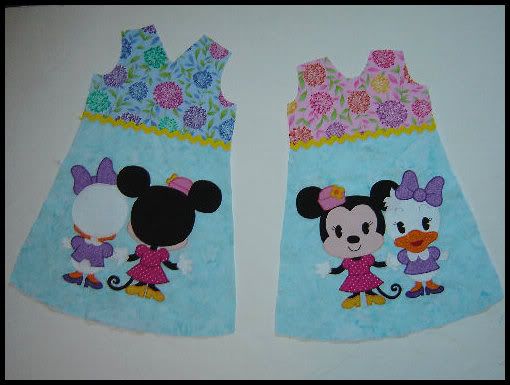
6) Stitch the lower edge of the front middle to the top edge of the front lower piece with right sides together. Make sure the center of each piece lines up. Repeat with the back middle and back lower pieces. Finish the seam and press toward the lower pieces.
Tip: Because the edges being sewn together are curved, it may help to pin the pieces before stitching.
Tip: As much as I try to be accurate when tracing, cutting and stitching, I find that I usually have slight 'overhang' where one piece might be slightly longer/wider than the piece to which it's sewn. When that happens, I just carefully trim the excess so it lines up evenly.
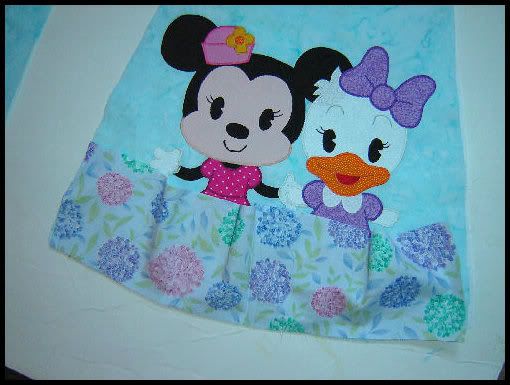
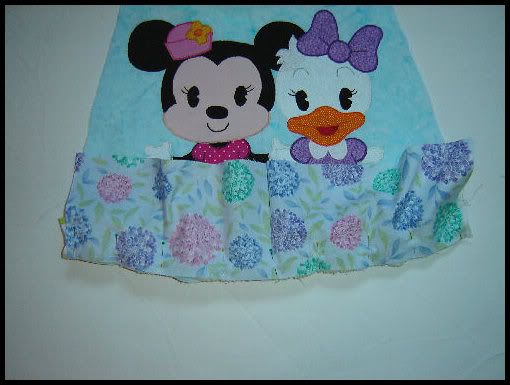
Tip: Although the pattern does not include ruffles, it's simple to add them to the bottom edge of the front/back middle. The size of the ruffles can vary based on your preference. I like to have the ruffles approximately 2" long after one edge is finished (this includes the seam allowance). I make the width before gathering twice the width of the lower edge of the middle piece. I don't worry about exact measurements, though. Basically I cut strips the full width of the fabric (42-44" wide), hem and gather with my ruffler foot. Once I’ve pinned it in place, I can trim off any excess length. The only problem with this method is that I find it hard to toss those little ruffles. Some day I'll gather then all up and use them in a twirl skirt. LOL
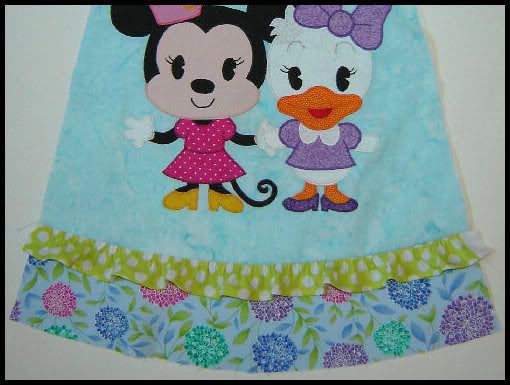
Tip: Once these pieces are stitched and the seam is finished, now is a good time to add ricrac or a similar trim over the seam line (or above the ruffle if one is added). Since the seam curves slightly, make sure whatever trim you use can follow the curve easily. That's why I like using ricrac on this seam. The seam at the bodice bottom is straight so non-curving trim, such as embroidered ribbon, can be used there easily.
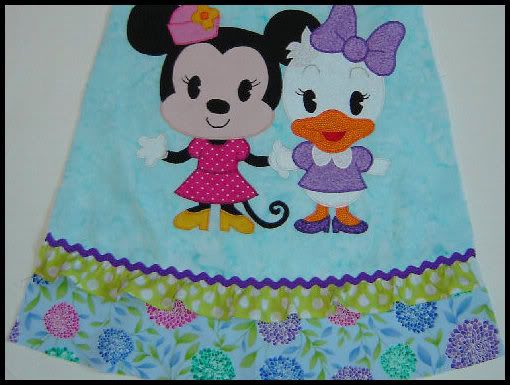
7) Stitch one side piece to the assembled front middle pieces with right sides together. Make sure the edge of the side piece stitched is the edge that curves outward at the middle (convex). Repeat with the other side piece that is a mirror image of the one used. Finish the seams and press toward the side. Repeat for the back piece. With right sides together, stitch assembled front and back along both side seams. Finish the seam and press toward the back.
Tip: Because the edges being sewn together are curved, it may help to pin the pieces before stitching.
Tip: Once the side pieces are stitched to the front and back, more trim or decorative stitching can be used on the finished seams.
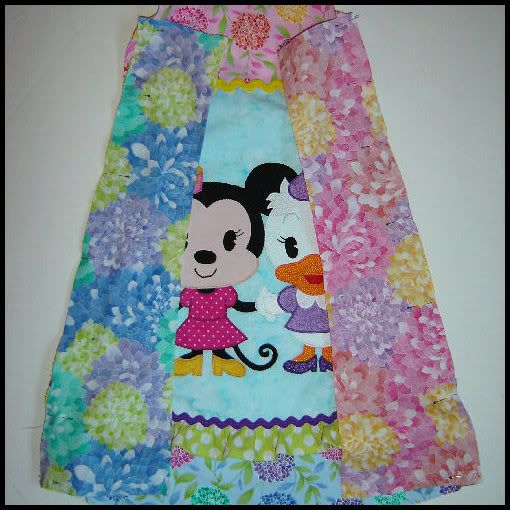
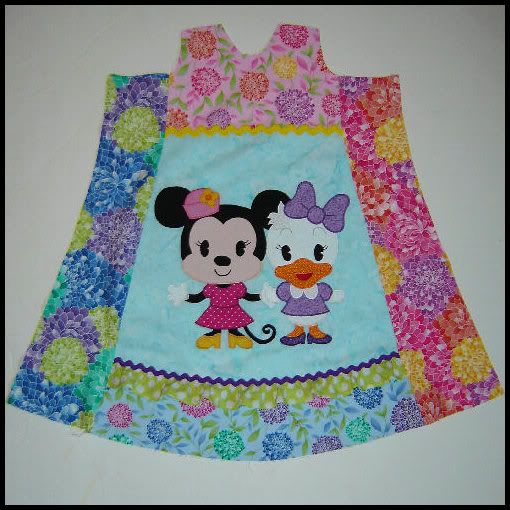
8) Stitch front bodice lining to back bodice lining at the side seams. Finish edges and press toward the front. Attach fusible interfacing to back center V and where the buttonholes will be located on the front.
Tip: To finish the lower edge of the lining, once the side seams are finished I serge along the lower edge trimming just a small amount as I go. This allows me to easily turn up an even amount as I press. I then stitch this in place.
Tip: I suggest pressing the lining side seams to the front so there is less bulk where the lining seams and dress side seams meet.
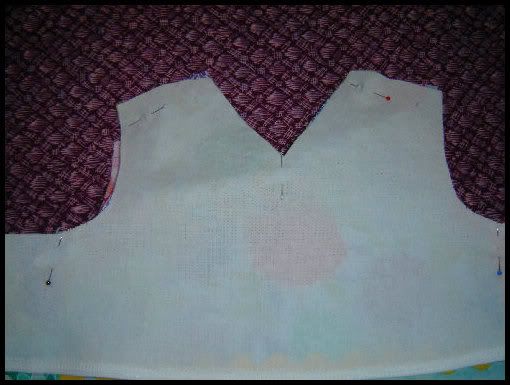
9) Fold one strap piece along the length right sides together and stitch the long edge only. Finger press the seam open and position the seam in the center. Stitch the short edge and trim excess fabric. Press the center seam open. Trim the excess fabric from the end including clipping the corners at an angle. This makes it easier to get a nice crisp point on each corner. Turn right side out and press again to center the seam along the back center of the strap. Repeat with second strap.
Tip: Even more ricrac or trim can be added to the strap. Sew it down the center of the strap lengthwise before stitching the strap. Once the length and end seams are sewn and the strap turned right side out, the trim should be centered on the finished strap.
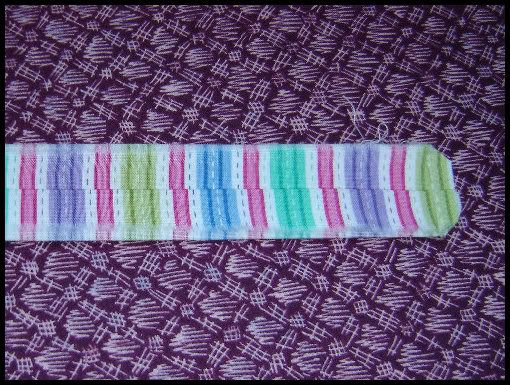
10) With lining inside out and dress right side out, pin the lining to the dress making sure to match the side seams, center front and center back. Stitch along the top edge leaving the place where the straps will be attached un-stitched. Insert straps between lining and dress so the unfinished edge lines up with the edge of the lining. The strap seam should be facing the right side of the lining. Stitch in place. Trim seam to reduce the bulk. Snip at the back center V just short of the stitching as well as along the curved edges of the armholes and front neck line. Be careful that you don’t clip the stitching on the seam. If you do, stitch that section again just a bit inside the original stitching. Turn the lining so it is inside the dress and press the seam.
Tip: I prefer to stitch the lining in place leaving the edges where the straps will be attached un-sewn. This way I don’t have to worry about the straps getting caught in a seam where they aren’t supposed to be. I also like to have the back bodice the same width as the straps where they are sewn together. The pattern actually has the bodice section wider than the straps but I think it looks nice to have the edges of the straps line up evenly with the edges of the bodice.
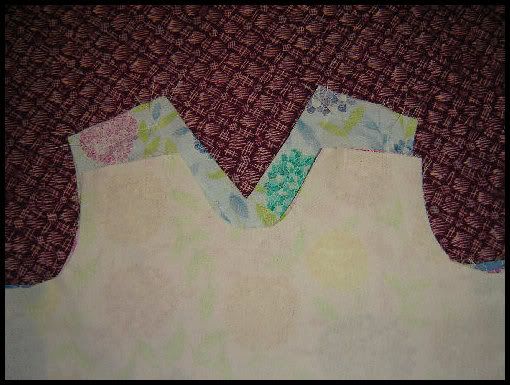
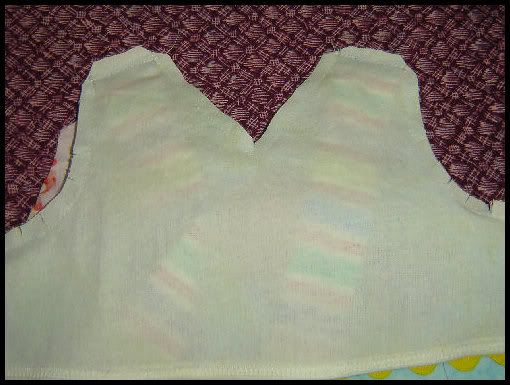
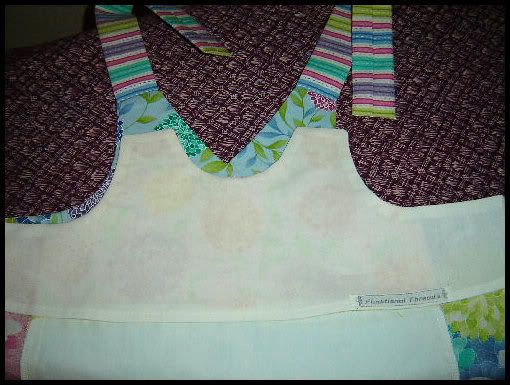
11) With lining and dress attached, you now need to create a casing on each side for elastic. Topstitch approximately 3/4” from the dress edge between the front seam and back seam. Repeat with the other side. Insert elastic cut to length into each casing. Stitch each end to secure.
Tip: The size of the casing will vary depending on the size of the elastic used. I typically use 1/2” elastic.
Tip: When securing the ends of the elastic, I “stitch in the ditch”, aka sew in the seam between the center and side pieces. After stitching once, I backstitch and stitch again.
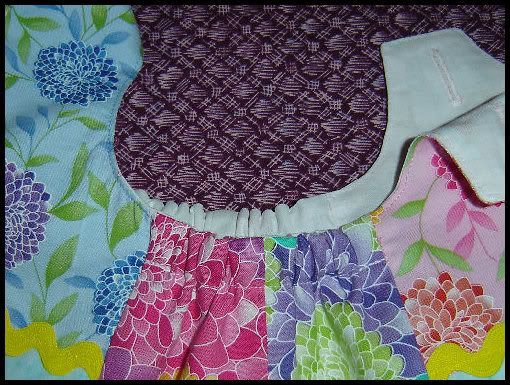
12) Topstitch the upper edge of bodice front and back.
Tip: Topstitching isn't mandatory but I think it helps keep the lining in place plus it gives a nice finished look to the bodice.

13) Finish the hem. The pattern calls for a simple hem. If you prefer, you can add a ruffle to the bottom.
Tip: Be aware that a ruffle will make the finished length longer than what is listed on the pattern! If you want to add a ruffle without adding length, you'll need to adjust the lengths of the other pieces to compensate for the length of the ruffle. For example, if you are adding a ruffle that will be 2 inches long when finished, take 1/2" off the bottom edge of the bodice and lower pieces, 1" off the length of the middle pieces and 2" off the length of the side piece.
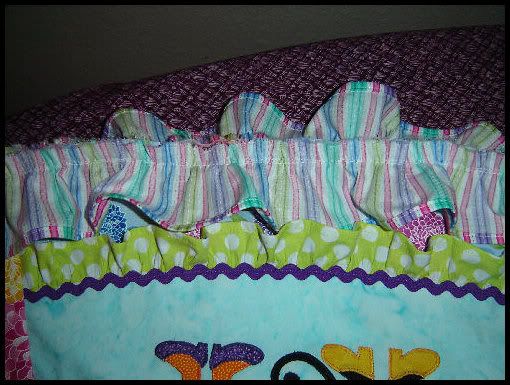
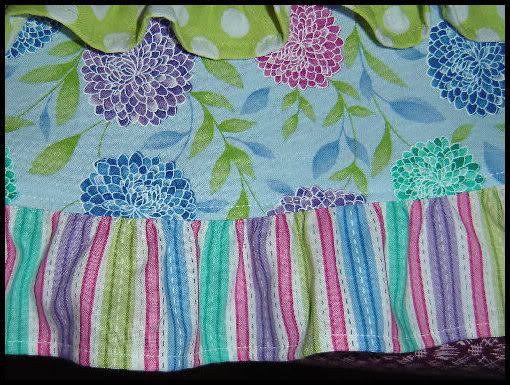
14) Determine the size and position of the buttonholes. Stitch buttonholes on both sides of the front bodice. Determine where you want the buttons on the straps and stitch in place.
Tip: Buttons are not the only way to secure the straps. Other options include clasps, knots, snaps, etc.
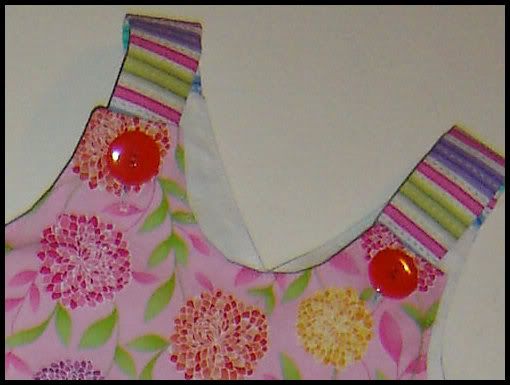
15) Congratulations, you are finished! Now all you need to do is sit back and watch your little princess glow as she models your latest creation.
I love the Farbenmix Vida dress. It's so versatile and fun to make. I also think it's a good pattern for people who are new to sewing while definitely a good 'canvas' for those who love to embellish a garment. I don't know how many dresses I've made but I certainly haven't run out of ideas. I especially love that I can easily use several prints on one dress - a great way to use some remnants from previous projects. Some day I want to make a dress where no two pieces are cut from the same print.
Although the pattern and instructions are easy to follow, I know some people find it helps to have more detailed steps and photos of the process. As such, I decided to document the main steps I go through as I create a dress. I hope this helps others as they start their own exploration of the possibilities with this pattern.
1) Farbenmix patterns are done in the 'Euro' style and do not include seam allowance. All pieces and sizes are printed on a single page of large paper. The pieces are not intended to be cut from that paper but instead it's necessary to trace each piece. Where the line is solid, all sizes share the same line. Where the sizes differ, the lines for each size is printed in a different type of line, i.e. dots, dashes, etc.
Tip: Go over the lines of the size you need with a colored pencil, crayon, highlighter or other tool to make it easier to see the line when tracing as described in step 2.

2) Trace all pattern pieces adding an even seam allowance to all sides of the piece EXCEPT where an edge is placed along a fold when cutting the fabric. For the Vida, this includes the center edge of these pieces: front upper (bodice), back upper (bodice), front bodice lining, back bodice lining, front/back middle and front/back lower. Transfer all pattern markings, such as grain line, to the traced piece. It also helps to label the pieces with their name and the size as well.
Tip: Plain white tissue paper is an inexpensive material to use for this purpose. However, if you'll be using the pattern repeatedly, using something more durable is a good idea. One option is to use non-woven lightweight interfacing (not the fusible kind). There is a product available at many fabric stores called Pattern Ease that is specifically designed for this type of use.
Tip: A simple tool to help you get an even seam allowance are two pencils taped or held together with a rubber band. Follow the line of the pattern with one pencil and have the other positioned so it goes along the outside of the pattern. As you trace the line, the second pencil will draw a parallel line that will be your cutting line.
Tip: I make dresses in a variety of sizes so I started color-coding my patterns when I trace them. For example all pieces for the size 86/92 are traced onto yellow tissue paper. This makes it easier for me to quickly find the right pattern pieces especially if I'm cutting two sizes out at once... something I do occasionally for sisters.

Cutting the Fabric
3) Cut all pieces as indicated on the pattern cutting list. Be sure to follow the markings for the grain line. For the pieces to be cut along the fold, place fabric with right sides together with the fold following the lengthwise grain of the fabric.
Tip: I love to use a different fabric for each main section of the dress. For example one fabric will be used for the front and back upper (bodice), a second for the front/back middle, a third for the front/back lower, a 4th for the straps (and I also use that fabric for an added bottom ruffle not included in the pattern) and one or two additional fabrics for the sides. I hate to use my wonderful fabric prints where they don't show so I typically use a solid fabric for the bodice lining.
Tip: If you plan to use different prints for the side panels, make sure you cut 2 with the pattern piece facing up (on the wrong side of the fabric) and 2 with the pattern piece facing down (on the wrong side of the fabric). What I like to do is use 2 different prints for the side. I have one fabric placed with right side up and lay the second over it with right side down. I then cut one set of pieces with the pattern right side up and repeat it exactly the same for the second set of pieces. By doing it this way, when the dress is finished, no two pieces of the same fabric are sewn together.
Tip: The side panels need to be cut slightly on the bias. This means the grain goes on an angle across the piece rather than straight up and down. To be sure I have the pattern piece oriented correctly, I measure from the marking on the pattern to the selvage of the fabric at both ends of the pattern piece.

Appliqué
4) Once all pieces are cut, it's time to add any appliqué or similar embellishment that won't be added over a seam.
5) Stitch the lower edge of the front upper (bodice) to the top edge of the front middle with right sides together. Make sure the center of each piece lines up. Repeat with the back upper (bodice) and back middle pieces. Finish the seam and press toward the bodice.
Tip: Once these pieces are stitched and the seam is finished, now is a good time to add ricrac or a similar trim over the seam line. This way the cut edge of the trim will be enclosed in seams in a later step.


6) Stitch the lower edge of the front middle to the top edge of the front lower piece with right sides together. Make sure the center of each piece lines up. Repeat with the back middle and back lower pieces. Finish the seam and press toward the lower pieces.
Tip: Because the edges being sewn together are curved, it may help to pin the pieces before stitching.
Tip: As much as I try to be accurate when tracing, cutting and stitching, I find that I usually have slight 'overhang' where one piece might be slightly longer/wider than the piece to which it's sewn. When that happens, I just carefully trim the excess so it lines up evenly.


Tip: Although the pattern does not include ruffles, it's simple to add them to the bottom edge of the front/back middle. The size of the ruffles can vary based on your preference. I like to have the ruffles approximately 2" long after one edge is finished (this includes the seam allowance). I make the width before gathering twice the width of the lower edge of the middle piece. I don't worry about exact measurements, though. Basically I cut strips the full width of the fabric (42-44" wide), hem and gather with my ruffler foot. Once I’ve pinned it in place, I can trim off any excess length. The only problem with this method is that I find it hard to toss those little ruffles. Some day I'll gather then all up and use them in a twirl skirt. LOL

Tip: Once these pieces are stitched and the seam is finished, now is a good time to add ricrac or a similar trim over the seam line (or above the ruffle if one is added). Since the seam curves slightly, make sure whatever trim you use can follow the curve easily. That's why I like using ricrac on this seam. The seam at the bodice bottom is straight so non-curving trim, such as embroidered ribbon, can be used there easily.

7) Stitch one side piece to the assembled front middle pieces with right sides together. Make sure the edge of the side piece stitched is the edge that curves outward at the middle (convex). Repeat with the other side piece that is a mirror image of the one used. Finish the seams and press toward the side. Repeat for the back piece. With right sides together, stitch assembled front and back along both side seams. Finish the seam and press toward the back.
Tip: Because the edges being sewn together are curved, it may help to pin the pieces before stitching.
Tip: Once the side pieces are stitched to the front and back, more trim or decorative stitching can be used on the finished seams.


8) Stitch front bodice lining to back bodice lining at the side seams. Finish edges and press toward the front. Attach fusible interfacing to back center V and where the buttonholes will be located on the front.
Tip: To finish the lower edge of the lining, once the side seams are finished I serge along the lower edge trimming just a small amount as I go. This allows me to easily turn up an even amount as I press. I then stitch this in place.
Tip: I suggest pressing the lining side seams to the front so there is less bulk where the lining seams and dress side seams meet.

9) Fold one strap piece along the length right sides together and stitch the long edge only. Finger press the seam open and position the seam in the center. Stitch the short edge and trim excess fabric. Press the center seam open. Trim the excess fabric from the end including clipping the corners at an angle. This makes it easier to get a nice crisp point on each corner. Turn right side out and press again to center the seam along the back center of the strap. Repeat with second strap.
Tip: Even more ricrac or trim can be added to the strap. Sew it down the center of the strap lengthwise before stitching the strap. Once the length and end seams are sewn and the strap turned right side out, the trim should be centered on the finished strap.

10) With lining inside out and dress right side out, pin the lining to the dress making sure to match the side seams, center front and center back. Stitch along the top edge leaving the place where the straps will be attached un-stitched. Insert straps between lining and dress so the unfinished edge lines up with the edge of the lining. The strap seam should be facing the right side of the lining. Stitch in place. Trim seam to reduce the bulk. Snip at the back center V just short of the stitching as well as along the curved edges of the armholes and front neck line. Be careful that you don’t clip the stitching on the seam. If you do, stitch that section again just a bit inside the original stitching. Turn the lining so it is inside the dress and press the seam.
Tip: I prefer to stitch the lining in place leaving the edges where the straps will be attached un-sewn. This way I don’t have to worry about the straps getting caught in a seam where they aren’t supposed to be. I also like to have the back bodice the same width as the straps where they are sewn together. The pattern actually has the bodice section wider than the straps but I think it looks nice to have the edges of the straps line up evenly with the edges of the bodice.



11) With lining and dress attached, you now need to create a casing on each side for elastic. Topstitch approximately 3/4” from the dress edge between the front seam and back seam. Repeat with the other side. Insert elastic cut to length into each casing. Stitch each end to secure.
Tip: The size of the casing will vary depending on the size of the elastic used. I typically use 1/2” elastic.
Tip: When securing the ends of the elastic, I “stitch in the ditch”, aka sew in the seam between the center and side pieces. After stitching once, I backstitch and stitch again.

12) Topstitch the upper edge of bodice front and back.
Tip: Topstitching isn't mandatory but I think it helps keep the lining in place plus it gives a nice finished look to the bodice.

13) Finish the hem. The pattern calls for a simple hem. If you prefer, you can add a ruffle to the bottom.
Tip: Be aware that a ruffle will make the finished length longer than what is listed on the pattern! If you want to add a ruffle without adding length, you'll need to adjust the lengths of the other pieces to compensate for the length of the ruffle. For example, if you are adding a ruffle that will be 2 inches long when finished, take 1/2" off the bottom edge of the bodice and lower pieces, 1" off the length of the middle pieces and 2" off the length of the side piece.


14) Determine the size and position of the buttonholes. Stitch buttonholes on both sides of the front bodice. Determine where you want the buttons on the straps and stitch in place.
Tip: Buttons are not the only way to secure the straps. Other options include clasps, knots, snaps, etc.

15) Congratulations, you are finished! Now all you need to do is sit back and watch your little princess glow as she models your latest creation.
Welcome!
Welcome to my latest attempt at a blog. I no longer have access to my old blog because it uses an old email I no longer have access to and forgot the password. Here's my old blog: http://funktionalthreads.blogspot.com/ As you can see, I used it for various subjects so starting fresh is likely a very good thing. With this blog I'll focus on sewing, patterns and related topics.
Subscribe to:
Posts (Atom)





